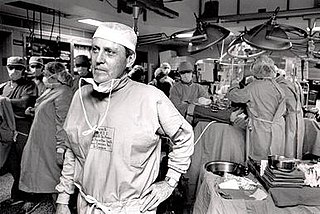Loading AI tools
American medical researcher (1926–2017) From Wikipedia, the free encyclopedia
Thomas Earl Starzl (March 11, 1926 – March 4, 2017) was an American physician, researcher, and expert on organ transplants. He performed the first human liver transplants, and has often been referred to as "the father of modern transplantation".[1] A documentary, entitled "Burden of Genius,"[2] covering the medical and scientific advances spearheaded by Starzl himself, was released to the public in 2017 in a series of screenings. Starzl also penned his autobiography, "The Puzzle People: Memoirs Of A Transplant Surgeon," which was published in 1992.
Thomas Starzl | |
|---|---|
 Starzl in 2005 | |
| Born | Thomas Earl Starzl March 11, 1926 |
| Died | March 4, 2017 (aged 90) Pittsburgh, Pennsylvania, U.S. |
| Nationality | American |
| Alma mater | Westminster College (BA) Northwestern University (MD, PhD) |
| Known for | Performed the first human liver transplant in 1963 Developed the clinical applications of cyclosporin Contributed to the field of immunosuppression |
| Parents |
|
| Scientific career | |
| Fields | Transplantation surgery, Immunology |
| Institutions | University of Pittsburgh |
Starzl was born on March 11, 1926, in Le Mars, Iowa, the son of newspaper editor and science fiction writer Roman Frederick Starzl and Anna Laura Fitzgerald who was a teacher and a nurse. He was the second of four siblings.[3] Originally intending to become a priest in his teenage years, Starzl changed his plans drastically when his mother died from breast cancer in 1947.[3]
He attended Westminster College in Fulton, Missouri, where he earned a Bachelor of Science degree in biology. Starzl attended Northwestern University Medical School in Chicago, where in 1950 he received a Master of Science degree in anatomy and in 1952 earned both a Ph.D. in neurophysiology and an M.D. with distinction.[4] While attending medical school, he established a long friendship with Professor Loyal Davis, MD, a neurosurgeon (whose wife Edith Luckett Davis' daughter from her first marriage was Nancy Reagan[3]).
Starzl spent an extra year at medical school, using the additional time to complete a doctorate in neurophysiology, in 1952. He wrote a seminal paper describing a technique to record the electrical responses of deep brain structures to sensory stimuli such as a flash of light or a loud sound. The paper is highly cited, having been referenced in 384 articles by January 2019.[5]
In 1959, he gained a Markle scholarship.[6]
After obtaining his medical degree, Starzl trained in surgery at Johns Hopkins Hospital in Baltimore and Jackson Memorial Hospital in Miami. At both places, he conducted lab and animal research, showing a keen interest in liver biology.[7]

Starzl was a surgeon and researcher in the then nascent field of organ transplantation at the University of Colorado from 1962 until his move to the University of Pittsburgh in 1981.
The Institute for Scientific Information released information in 1999 that documented that his work had been cited more than any other researcher in the world. Between 1981 and June 1998, he was cited 26,456 times.[3]
His autobiographical memoir, The Puzzle People, was named by The Wall Street Journal as the third best book on doctors' lives[8] and was written in three months.[9]
Starzl's most notable accomplishments include:


Starzl was named one of the most important people of the Millennium, ranking No. 213, according to the authors of "1,000 Years, 1,000 People: Ranking the Men and Women Who Shaped the Millennium " (Kodansha America, 332 pp.)
Starzl has also received honorary degrees from 26 universities in the United States and abroad, which include 12 in Science, 11 in Medicine, 2 in Humane Letters, and 1 in Law.[26]
In 2006, at a celebration for his 80th birthday, the University of Pittsburgh renamed one of its newest medical research buildings the Thomas E. Starzl Biomedical Science Tower in recognition of his achievements and contributions to the field.[27] On October 15, 2007, the Western Pennsylvania American Liver Foundation and the City of Pittsburgh honored Starzl by dedicating Lothrop Street, near his office and the biomedical research tower bearing his name, as "Thomas E. Starzl Way".[28]
A statue honoring Starzl was unveiled on June 24, 2018 on the University of Pittsburgh campus near the school's Cathedral of Learning.[29]
Having retired from clinical and surgical service since 1991, Starzl devoted his time to research endeavors and remained active as professor of surgery at the University of Pittsburgh School of Medicine and the University of Pittsburgh Medical Center's (UPMC) program named in his honor: the Thomas E. Starzl Transplantation Institute. Since his "retirement," he earned the additional distinctions of being one of the most prolific scientists in the world as well as the most cited scientist in the field of clinical medicine.[31]
Seamless Wikipedia browsing. On steroids.
Every time you click a link to Wikipedia, Wiktionary or Wikiquote in your browser's search results, it will show the modern Wikiwand interface.
Wikiwand extension is a five stars, simple, with minimum permission required to keep your browsing private, safe and transparent.